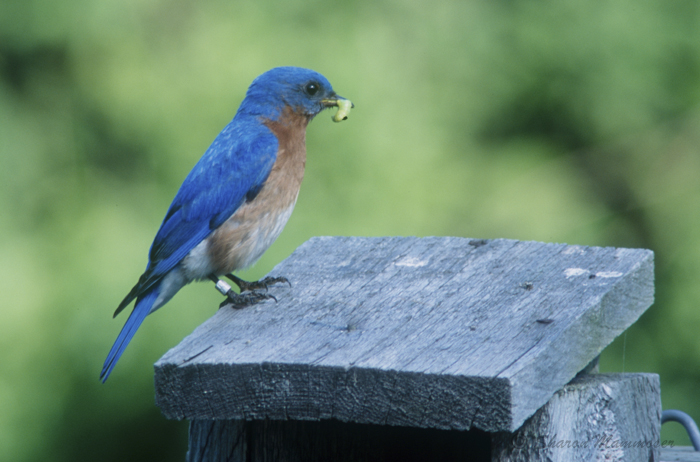 There are 5 baby bluebirds in the nesting box in our yard and from day one we have watched with delight their every move with the spy camera we installed in the box. They are days away from fledging, or leaving the nest and though I will be happy to see them go and be on their own, I will also be sad that my opportunity for watching them will come to an end. Having a camera in the box has been a wonderful and rare experience. It was not hard to choose the Eastern Bluebird as this week’s creature feature. Here are some interesting facts about bluebirds:
There are 5 baby bluebirds in the nesting box in our yard and from day one we have watched with delight their every move with the spy camera we installed in the box. They are days away from fledging, or leaving the nest and though I will be happy to see them go and be on their own, I will also be sad that my opportunity for watching them will come to an end. Having a camera in the box has been a wonderful and rare experience. It was not hard to choose the Eastern Bluebird as this week’s creature feature. Here are some interesting facts about bluebirds:
1. Perhaps one of the most interesting things about bluebirds is that their feathers are not blue! Instead, the blue is a result of a structure of the feather, rather than a blue pigment. This is true of blue jays too.
2. There are several species of bluebirds in the United States: Eastern Bluebirds, Western Bluebirds and Mountain Bluebirds. All feed on insects, fruit and berries.
3. Bluebirds are found in open country, preferring patchy vegetation with large trees for nesting. They are cavity nesters, taking over old woodpecker holes or using nest boxes. Unlike woodpeckers, they cannot create the holes in which they nest. The females build the nests alone–males guard from a safe perch, watching to make sure the female doesn’t mate with other males.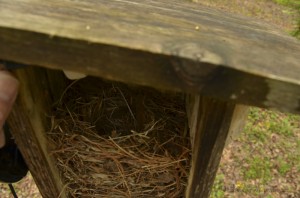
4. Only the female incubates the 4-6 blueish eggs and she will not begin incubating until all of the eggs have been laid. Once started, she will lay one egg a day until they all have been laid. Then she will begin incubation, though this might be one or two days after the last egg has been laid. She will maintain the nest at about 98-100 degrees during incubation.
5. Both the female and male feed the growing chicks. They return to the nest with spiders, grubs, caterpillars, beetles, bugs and other insects, taking turns with the housekeeping duties.
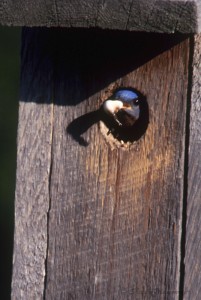 6. The adults eat the eggshells of the hatching babies and remove the poop sacs of the babies, taking them away from the nest box and depositing them in the woods so predators won’t be attracted to the nest.
6. The adults eat the eggshells of the hatching babies and remove the poop sacs of the babies, taking them away from the nest box and depositing them in the woods so predators won’t be attracted to the nest.
7. They tend to use the same nests for multiple broods, having as many as 3 broods per season. Those birds born in early spring will leave the nest and go off on their own, but birds born later may stay with the adults through the winter.
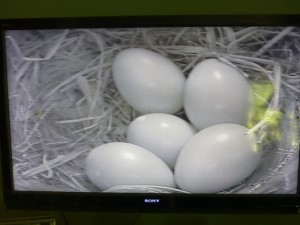 8. Interestingly, male bluebirds will continue to care for the young birds after they have left the nest while females may begin to re-nest. They will likely reuse the same nest.
8. Interestingly, male bluebirds will continue to care for the young birds after they have left the nest while females may begin to re-nest. They will likely reuse the same nest.
9. Bluebirds catch prey in a method called drop hunting. This means they perch from a wire or tree branch and look down over the ground, searching for insects. When they see one, they drop down to snag it out of the air.
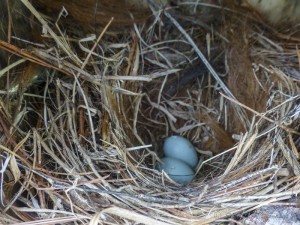 10. An average bluebird consumes about 4 grams of food per day, or 12% of their body weight. If a person weighing 200 pounds consumed the same amount of food, it would be like eating 24 pounds of food per day!
10. An average bluebird consumes about 4 grams of food per day, or 12% of their body weight. If a person weighing 200 pounds consumed the same amount of food, it would be like eating 24 pounds of food per day!

